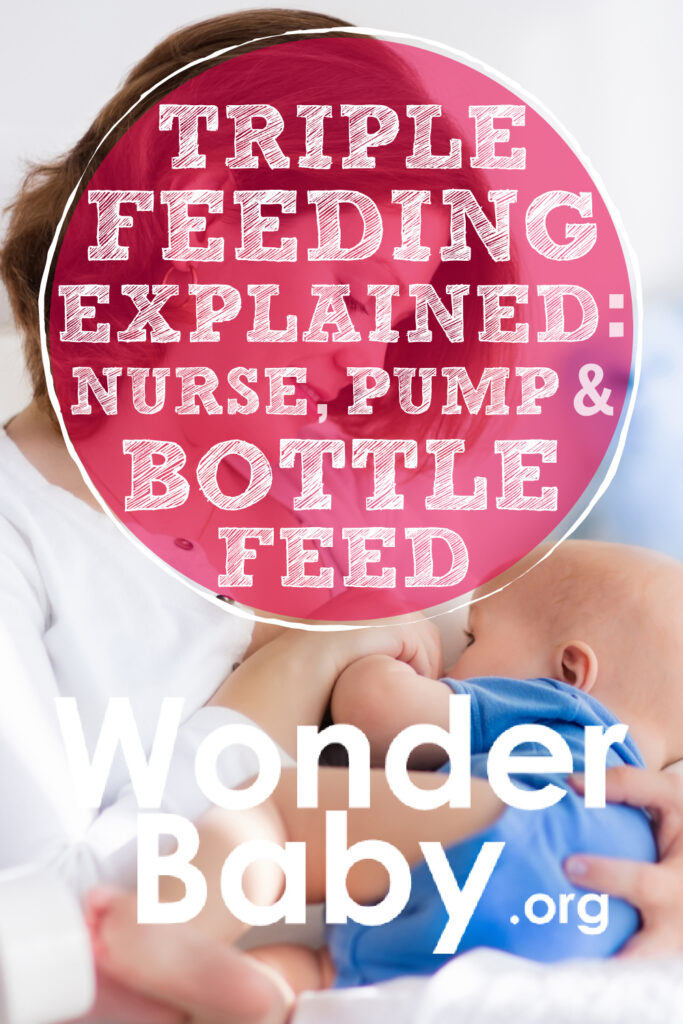Triple Feeding Explained: Nurse, Pump, & Bottle Feed

- Triple feeding involves breastfeeding, pumping breast milk, and bottle feeding.
- This strategy is a temporary solution if you experience breastfeeding issues.
- Triple feeding can help stimulate milk production and improve infant weight gain.
- Triple feeding requires a significant amount of dedication.
Breastfeeding is a beautiful experience. It can help you create an unmatched bond with your newborn during the first few weeks of their life. I was excited to breastfeed our firstborn and felt prepared—but, unfortunately, I struggled. Our daughter didn’t latch properly due to a lip tie. My nipples were bleeding, and I cried most of the time. I had no choice but to begin triple feeding.
Triple feeding is a feeding method that involves breastfeeding, pumping, and bottle feeding. Healthcare professionals often recommend it when your baby has trouble feeding directly, is losing weight, or your mental health takes a toll from exclusively breastfeeding.
This complete guide to triple feeding will help you to get started. You’ll find out what it is, how it can benefit your breastfeeding journey, and what other moms did to survive the process.
Triple Feeding: What You Need to Know
Triple feeding can be a temporary solution if you experience breastfeeding issues. While it can be time-consuming, triple feeding has helped many moms, including me, continue their breastfeeding journey. This method can also provide some flexibility even if your baby doesn’t struggle to feed directly.
You can choose to triple feed if you find it more convenient. However, most moms triple feed out of necessity. This feeding method can become exhausting! Triple feeding could be helpful if:
- Your baby is latching and unlatching repeatedly.
- Your baby isn’t getting enough nutrition to thrive.
- Your milk supply is low.
- You need a mental break from breastfeeding.
Triple feeding involves three stages. These are:
- Breastfeeding
- Pumping breast milk
- Giving your baby the pumped breast milk in a bottle or supplementing it with formula if needed
You’ll need to follow the triple feeding process every two to three hours around the clock while your baby is a newborn. This will help you establish and maintain a good milk supply.
Benefits and Drawbacks of Triple Feeding

Triple feeding can be effective but draining. It shouldn’t be your long-term plan. If you’re considering this feeding method, you need to ensure you have support. Here are some benefits and drawbacks to weigh before making a decision:
The Benefits of Triple Feeding
Triple Feeding Ensures Your Baby Receives Enough Nutrition
The main advantage of triple feeding is the insight it gives you of how much breast milk your baby takes in. This is particularly important if your newborn is premature or has medical conditions that can impact their ability to breastfeed. Triple feeding ensures your baby benefits from your milk while you’re figuring out how to feed directly.
Triple Feeding Can Help Increase Your Milk Supply
If you notice a sudden drop in your milk supply, triple feeding can help stimulate production. Pumping breast milk can signal your body to produce more milk, especially when you do this after a direct feeding session. You’ll establish a consistent milk supply over time.
Triple Feeding Can Provide Flexibility
Triple-fed babies have an easier time drinking from a bottle and taking milk from someone other than their mother. This can be helpful if you need to be away from your baby for work or other responsibilities. Your partner could also help with feeding sessions if you need a break.
The Drawbacks of Triple Feeding
Triple Feeding Can Be Time-Consuming
Triple feeding requires a significant amount of dedication. The process can be draining even if you have a good breast pumping schedule and excellent support. It takes up a lot of time, especially during the newborn stage. This can lead to sleep deprivation and physical exhaustion.
If you don’t take proper care of yourself, triple feeding can impact your mental health and ability to care for your baby.
Triple Feeding Can Interfere With Breastfeeding
Whether breastmilk or formula, bottle feeding your baby can interfere with the natural breastfeeding process. Triple feeding can make it more difficult for your baby to latch onto the breast. Your baby could also develop a preference for bottles. If you’d like to breastfeed directly, weaning them could be challenging.
Triple Feeding Can Cause Nipple Confusion
Babies have the instinct to suckle. Whether you introduce the breast or a bottle, your infant will know they have to nurse it for nutrition. However, switching between different types of nipples can cause confusion. This could lead to frustration and refusal of both the breast and bottle.
How Long Does It Take for Triple Feeding to Work?

The goal of triple feeding is to increase your baby’s milk intake while also increasing your milk supply and addressing any latching issues. You can notice results within a few days or sometimes only after weeks.
If you’re triple feeding to increase your milk supply, you’ll know it’s working when you pump higher volumes of milk per session. A stronger letdown is another indication that more milk is available. Similarly, your baby’s weight gain could be a sign that triple feeding works if you’re doing it for this reason.
How to Triple Feed Effectively: A Guide
Triple feeding is not an easy process. You need a lot of determination to make it work.
Fellow mom Susan Trindle shared her triple feeding journey with Lifecycle Womancare. You can also read how Sarah Schindler survived this feeding method in a story she wrote for The Bump. Learning how other moms triple fed and what they did to make the journey easier can help you along the way.
There isn’t one right way to triple feed. However, following a few guidelines can help you do so effectively and increase your chances of success.
Breastfeed: If breastfeeding directly is one of your goals, always begin your feeding sessions by offering your breast to your baby. This will help them practice latching and stimulate milk production. You can switch your baby between breasts or power pump on the open breast.
Supplement: After breastfeeding, offer your baby a supplement of expressed milk, formula or donor milk. You can give this through a bottle or syringe. How much supplement you’ll need will depend on your baby’s needs. You can determine their need with the help of a healthcare professional.
Pump: Once your baby has finished their feeding session, you need to stimulate further milk production through pumping. You can pump for 10–15 minutes or until your breasts feel empty. Store the milk in milk storage bags for future use or in a bottle in the fridge for the next feeding session.
Tips For Effectively Triple Feeding

Many mothers have successfully used triple feeding to increase their milk supply and promote their baby’s growth and development. Here are some tips to help you do the same:
- Establish a regular feeding and pumping schedule. This will ensure your baby receives enough milk and your milk supply is maintained. Aim to feed every 2–3 hours and pump after each session. If your milk supply still seems low, add additional pumping sessions.
- Seek support from a lactation consultant. Professional guidance on proper feeding techniques, baby weight, and maintaining milk supply can make triple feeding less stressful.
- Take care of yourself. Get plenty of rest, eat a healthy diet, and stay hydrated. Do something enjoyable while you pump, like watching your favorite series or listening to a podcast. You can also join a support group for breastfeeding mothers.
- Use a hospital-grade pump. If you’re struggling with low supply, a quality breast pump is essential for expressing milk efficiently. You can also choose a portable pump for a more comfortable experience.
When and How to Stop Triple Feeding
Knowing when to stop triple feeding depends on why you initiated it in the first place. If your baby perfected their latch, is gaining weight, and your milk supply has increased, then it may be time to stop triple feeding.
Working closely with a lactation consultant or your baby’s pediatrician can help you make this decision at the right time. Some signs that may indicate that it is time to stop triple feeding include:
- Your baby is gaining weight at an appropriate rate.
- Your baby is meeting their developmental milestones.
- Your milk supply has increased to meet your baby’s needs.
- Your baby is breastfeeding effectively and taking in enough milk at each feeding.
If you feel stressed and overwhelmed during the process, it’s also a good idea to stop triple feeding.
Once you’ve decided to stop triple feeding, you can gradually reduce the amount of supplement you provide and increase breastfeeding frequency. It’s possible to exclusively breastfeed within days if your milk supply has increased and your baby has no issues latching.
Manage Low Milk Supply and Latching Issues with Triple Feeding
Triple feeding can improve milk production and weight gain in infants. It can also establish a stronger breastfeeding relationship between you and your baby. If you’re struggling with low milk supply, latching issues, or your mental health, you should seek support from a lactation consultant or healthcare professional. They can help you develop a feeding plan that meets your needs and preferences.
You can also do several things to make triple feeding more manageable. These include establishing a regular feeding and pumping schedule, seeking support from family and friends, staying hydrated and nourished, and taking care of your emotional well-being.
You should only triple feed for a short period. As your milk supply increases and your baby’s weight gain improves, you can gradually reduce the amount of supplement you need and continue your exclusive breastfeeding journey.

Related Posts

Breastfeeding, Sleep
Sleep and Breastfeeding: A Comprehensive Guide for Nursing Moms
Many people assume breastfeeding and sleep training don’t go together, but it is possible to help your baby sleep better while continuing your breastfeeding journey.

Breastfeeding
Comfort Nursing: Pros, Cons, and How to Stop
Find out what comfort nursing is, when should you worry about it, and how to stop or limit your baby's comfort nursing (especially at night!).

Breastfeeding, Product Reviews
5 Best Breastfeeding Chairs for Nursing Moms of 2023
Whether you want a gentle rock, a smooth glide, or a cozy cuddle to soothe your baby to sleep, you’ll have your pick of the best breastfeeding chairs on the...